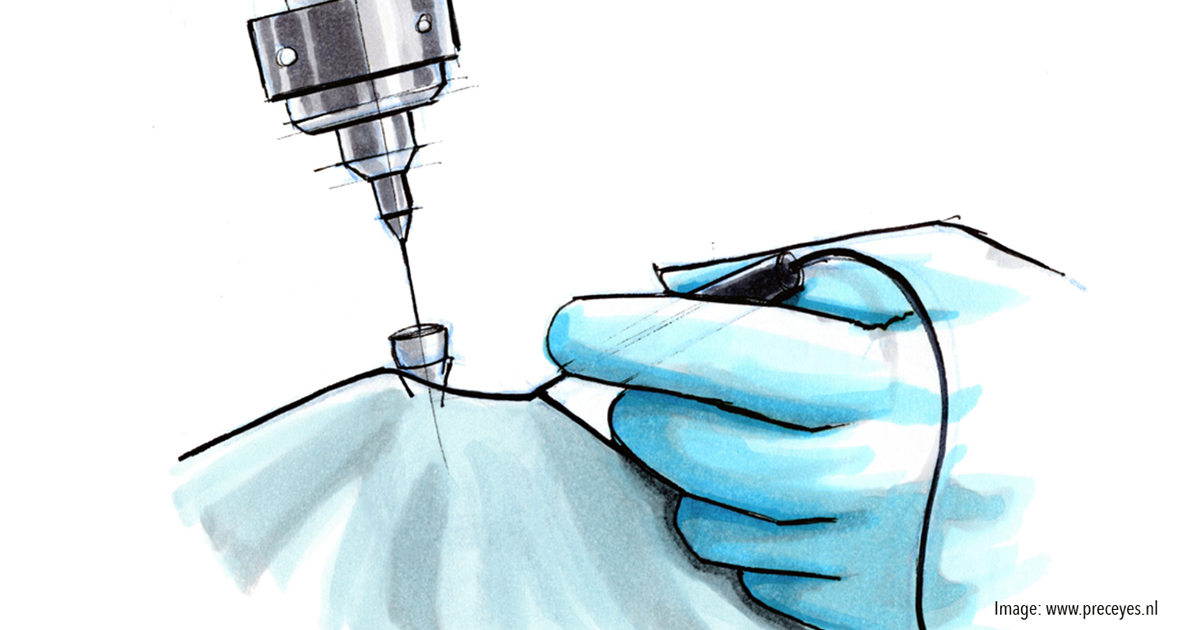Preceyes Takes Robotic Surgery Platform, Trial Results to Euretina and AAO

Netherlands-based Preceyes BV seems to have taken the lead in the race to develop a robotic platform for retinal surgery as it prepares to demonstrate its system this week at Euretina 2018 in Vienna and then report on results of the first trial of the robot in humans at the American Academy of Ophthalmology meeting next month in Chicago.
The trial, conducted at John Radcliffe Hospital at the University of Oxford in England, involved 12 patients undergoing surgical peels of the inner limiting membrane (ILM) and epiretinal membrane (ERM). Results were first published online in June in the journal Nature Biomedical Engineering. Matteo Cereda, MD, a retinal surgeon at Sacco Eye Clinic in Milan, will report on the PRECEYES Surgical System at AAO.
Trial Results
In the trial, the 12 patients were randomly assigned to robot-assisted surgery or standard manual surgery. All surgeries were completed successfully, and all study subjects experienced an improvement in vision.
The trial showed that robotic surgery took longer than manual surgery, an average of 44 minutes versus 31 minutes. Also, raising the flap of the ILM or ERM took 4 minutes, 55 seconds in robotic surgery versus 1 minute, 20 seconds in manual surgery.
In the second phase of the trial, the team used the robot to inject recombinant tissue plasminogen activator subretinally to displace hemorrhage under local anesthesia. Says primary investigator Robert MacLaren, MB, ChB, DPhil, “Our next step will be to use the robotic surgical device for precise and minimally traumatic delivery of a gene therapy to the retina, which will be another first-in-man achievement and is set to commence in early 2019.”
Marc D. de Smet, MD, CMO of Preceyes BV, the Eidhoven, Netherlands, medical robotics firm that designed and developed the PRECEYES Surgical System, states, “The robot can and will play an ever-increasing role in current surgery and enable new surgical procedures. Our PRECEYES Surgical System will provide increased precision where and when it is required by a surgeon, and it is anticipated that it will foster more consistency in the conduct of surgical tasks.”
At Euretina, retinal surgeons will be able to test the PRECEYES system and perform a robot-assisted peeling in a model eye. The 30-minute demonstration involves an introduction to the system and model, a manual peeling trial, and a robot-assisted trial. Preceyes representatives will interview surgeons afterward to gather feedback.
Oxford University signed an agreement with Preceyes to test the robotic surgical system in 2016.
Other Efforts in Ophthalmic Robotics
In a July 2017 article in Retina, Roomasa Channa, MD, and colleagues spelled out the potential advantages of robotic retinal surgery. “Ophthalmic surgery, particularly vitreoretinal surgery, might have reached the limits of human physiologic performance,” they wrote. “Robotic assistance can help overcome biologic limitations and improve our surgical performance. Clinical studies of robotic-assisted surgeries are needed to determine safety and feasibility of using this technology in patients.” (Retina 2017;37:1220–28)
Auris Surgical Robotics had been working on a platform for cataract surgery, but the company has since changed its name to Auris Health and has focused on a collaboration with Johnson & Johnson’s Ethicon unit to develop a robotic platform for surgical endoscopy. In March, Auris received Food and Drug Administration approval of its Monarch platform in bronchoscopy. In 2016 Auris acquired Hansen Medical with the intent of developing a platform for intravascular robotics. Auris doesn’t even mention “ophthalmology” or “cataract” on its website.
Other surgical platforms have emerged in ophthalmology, but none have achieved in-human posterior segment surgery on the scale of the Preceyes platform. A review article in the journal Eye and Brain this year (Eye Brain 2018;10:13–24) reported on efforts at the University of California, Los Angeles, called the intraocular robotic interventional surgical system (IRISS). The researchers performed two anterior segment procedures (capsulorhexis and opaque lens removal), and two posterior segment procedures (central vitrectomy and simulation of temporal retinal microcannulation) in pig eyes. The article also noted efforts by researchers at Johns Hopkins to develop a surgical robot to perform ocular microsurgery.
For questions about this article, please contact Richard Mark Kirkner at rich@healthegy.com.
